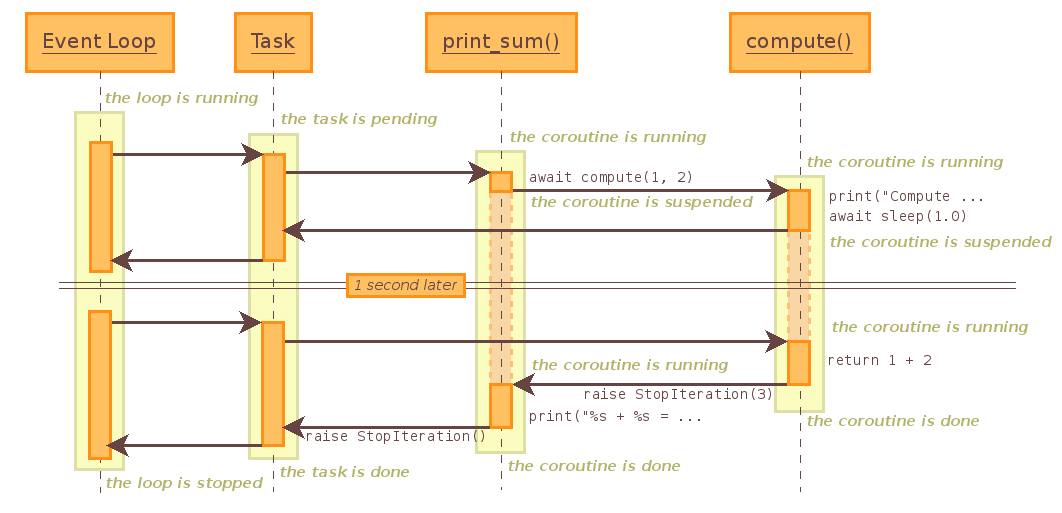Generator
Generator能保存自己的状态,进入一种“Paused”状态,再次调用时会继续执行。
Generator的好处之一是节省了存储空间开销,带一些”流处理”的思想。
其实,我们也可以对Generator进行传入数据的操作:
def coro():
hello = yield "Hello"
yield hello
c = coro()
print(next(c))
print(c.send("World"))
Coroutine
coroutine可以认为是generator思想的泛化:
- generator一个一个地吐出数据(返回值)
- coroutine一个一个地吃掉数据(传入参数)并返回结果,即可控地执行函数
关键点在于,generator与coroutine都能保存自己的状态,而这种特点正可以用于任务切换。yield可以看做是操作系统在进行进程管理时的traps:

实际上,coroutine可以看做”用户自定义”的进程,状态、启用和暂停都可控,David Beazley就利用这一点用coroutine实现了Python上的操作系统(参见Reference)。
Conroutine与Concurrent Programming
Concurrent Programming中有Task的概念,有如下特点:
- 独立的控制流
- 内部状态变量
- 支持计划任务(暂停、恢复执行)
- 与其他Task通信
@coroutine
def grep(pattern): #正则匹配
print "Looking for %s" % pattern
while True:
line = (yield)
if pattern in line:
print line,
conroutine有自己的控制流(while/if),有局部变量(pattern, line),能暂停和恢复(yield()/send()),能相互通信(send())
====》coroutine就是一种Task!
Python Docs中提供了一个例子:
import asyncio
async def compute(x, y):
print("Compute %s + %s ..." % (x, y))
await asyncio.sleep(1.0)
return x + y
async def print_sum(x, y):
result = await compute(x, y)
print("%s + %s = %s" % (x, y, result))
loop = asyncio.get_event_loop()
loop.run_until_complete(print_sum(1, 2))
loop.close()
执行方式如下图:

利用coroutine,可以在一个线程(Task)上实现异步。
Impletation
coroutine有两种实现方式,基于generator和原生async, awati关键字。
generator based coroutine
import asyncio
import datetime
import random
@asyncio.coroutine
def display_date(num, loop):
end_time = loop.time() + 50.0
while True:
print("Loop: {} Time: {}".format(num, datetime.datetime.now()))
if (loop.time() + 1.0) >= end_time:
break
yield from asyncio.sleep(random.randint(0, 5))
loop = asyncio.get_event_loop()
asyncio.ensure_future(display_date(1, loop))
asyncio.ensure_future(display_date(2, loop))
loop.run_forever()
上面的程序实现了在同一个线程里交互执行两个函数(sleep),而又能保持各自的状态
Native support(python 3.5+)
只需要修改函数定义头和yield from为关键字await即可。
async def display_date(num, loop, ):
end_time = loop.time() + 50.0
while True:
print("Loop: {} Time: {}".format(num, datetime.datetime.now()))
if (loop.time() + 1.0) >= end_time:
break
await asyncio.sleep(random.randint(0, 5))
拾遗
Coroutine常翻译成“协程”。